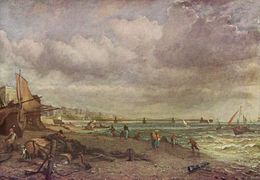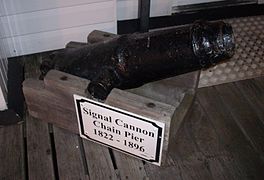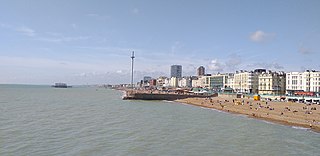
Brighton is a seaside resort and one of the two main areas of the City of Brighton and Hove in the county of East Sussex, England. It is located 47 miles (76 km) south of London.

John Constable was an English landscape painter in the Romantic tradition. Born in Suffolk, he is known principally for revolutionising the genre of landscape painting with his pictures of Dedham Vale, the area surrounding his home – now known as "Constable Country" – which he invested with an intensity of affection. "I should paint my own places best", he wrote to his friend John Fisher in 1821, "painting is but another word for feeling".

London Bridge is a central London railway terminus and connected London Underground station in Southwark, south-east London. It occupies a large area on three levels immediately south-east of London Bridge, from which it takes its name. The main line station is the oldest railway station in London fare zone 1 and one of the oldest in the world having opened in 1836. It is one of two main line termini in London to the south of the River Thames and is the fourth-busiest station in London, handling over 50 million passengers a year.
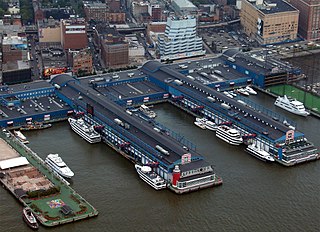
A pier is a raised structure that rises above a body of water and usually juts out from its shore, typically supported by piles or pillars, and provides above-water access to offshore areas. Frequent pier uses include fishing, boat docking and access for both passengers and cargo, and oceanside recreation. Bridges, buildings, and walkways may all be supported by architectural piers. Their open structure allows tides and currents to flow relatively unhindered, whereas the more solid foundations of a quay or the closely spaced piles of a wharf can act as a breakwater, and are consequently more liable to silting. Piers can range in size and complexity from a simple lightweight wooden structure to major structures extended over 1,600 m (5,200 ft). In American English, a pier may be synonymous with a dock.

The London, Brighton and South Coast Railway was a railway company in the United Kingdom from 1846 to 1922. Its territory formed a rough triangle, with London at its apex, practically the whole coastline of Sussex as its base, and a large part of Surrey. It was bounded on its western side by the London and South Western Railway (L&SWR), which provided an alternative route to Portsmouth. On its eastern side the LB&SCR was bounded by the South Eastern Railway (SER)—later one component of the South Eastern and Chatham Railway (SE&CR)—which provided an alternative route to Bexhill, St Leonards-on-Sea, and Hastings. The LB&SCR had the most direct routes from London to the south coast seaside resorts of Brighton, Eastbourne, Worthing, Littlehampton and Bognor Regis, and to the ports of Newhaven and Shoreham-by-Sea. It served the inland towns and cities of Chichester, Horsham, East Grinstead and Lewes, and jointly served Croydon, Tunbridge Wells, Dorking and Guildford. At the London end was a complicated suburban and outer-suburban network of lines emanating from London Bridge and Victoria, and shared interests in two cross-London lines.

The West Pier is a ruined pier in Brighton, England. It was designed by Eugenius Birch and opened in 1866. It was the first pier to be Grade I listed in England and Wales but has become increasingly derelict since its closure to the public in 1975. As of 2022 only a partial metal framework remains.

Volk's Electric Railway (VER) is a narrow gauge heritage railway that runs along a length of the seafront of the English seaside resort of Brighton. It was built by Magnus Volk, the first section being completed in August 1883, and is the oldest operational electric railway in the world, though it was not the first electric railway to be built. It was preceded by electrification of Miller's line in 1875, Werner von Siemens' 1879 demonstration line in Berlin and by the Gross-Lichterfelde Tramway of 1881, although none of these remain in operation.

New Brighton is a seaside resort in Wallasey, Merseyside, England, at the northeastern tip of the Wirral peninsula. It has sandy beaches which line the Irish Sea and mouth of the Mersey, and the UK's longest promenade.
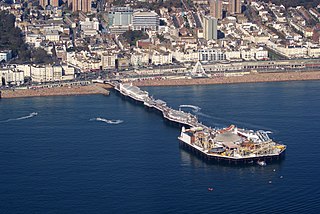
The Brighton Palace Pier, commonly known as Brighton Pier or the Palace Pier, is a Grade II* listed pleasure pier in Brighton, England, located in the city centre opposite the Old Steine. Established in 1899, it was the third pier to be constructed in Brighton after the Royal Suspension Chain Pier and the West Pier, but is now the only one still in operation. It is managed and operated by the Eclectic Bar Group.

William Denny and Brothers Limited, often referred to simply as Denny, was a Scottish shipbuilding company.
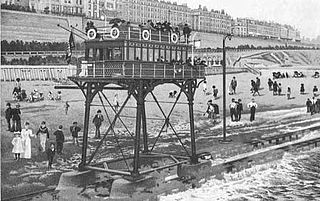
The Brighton and Rottingdean Seashore Electric Railway was a unique coastline railway in Brighton, England, that ran through the shallow coastal waters of the English Channel between 1896 and 1901. It was designed by Magnus Volk to extend his Volk's Electric Railway from its terminus in Paston Place to the village of Rottingdean and avoid difficult terrain. While the unique railroad was popular and carried tens of thousands of passengers, it was ultimately abandoned to make room for new sea defences, and Volk was unable to raise the funds to construct a replacement.
A chain pier was a type of pier. It may refer to:

William Miller was a Scottish Quaker line engraver and watercolourist from Edinburgh.
Captain Sir Samuel Brown of Netherbyres KH FRSE was an early pioneer of chain design and manufacture and of suspension bridge design and construction. He is best known for the Union Bridge of 1820, the first vehicular suspension bridge in Britain.
Events from the year 1823 in the United Kingdom.

Park Crescent is a mid-19th-century residential development in the Round Hill area of Brighton, part of the English city of Brighton and Hove. The horseshoe-shaped, three-part terrace of 48 houses was designed and built by one of Brighton's most important architects, Amon Henry Wilds; by the time work started in 1849 he had 35 years' experience in the town. Wilds used the Italianate style rather than his more common Regency motifs. Three houses were replaced after the Second World War because of bomb damage, and another was the scene of one of Brighton's notorious "trunk murders" of the 1930s. The three parts of the terrace, which encircle a private garden formerly a pleasure ground and cricket pitch, have been listed at Grade II* by English Heritage for their architectural and historical importance.
Frederick Dale Banister MICE, was an English civil engineer, best known for his 35 years as the Chief Engineer of the London, Brighton and South Coast Railway (LB&SCR).

Trinity Chain Pier, originally called Trinity Pier of Suspension, was built in Trinity, Edinburgh, Scotland in 1821. The pier was designed by Samuel Brown, a pioneer of chains and suspension bridges. It was intended to serve ferry traffic on the routes between Edinburgh and the smaller ports around the Firth of Forth, and was built during a time of rapid technological advance. It was well used for its original purpose for less than twenty years before traffic was attracted to newly developed nearby ports, and it was mainly used for most of its life for sea bathing. It was destroyed by a storm in 1898; a building at the shore end survives, much reconstructed, as a pub and restaurant called the Old Chain Pier.

Dunoon Pier is a Victorian pier in the Scottish town of Dunoon, Argyll and Bute. Completed in its current form in 1898, and reaching out into the Firth of Clyde, its earliest parts date back to 1835. It is now a Category A listed structure and, according to Historic Environment Scotland, the best surviving example of a timber ferry pier in Scotland.



